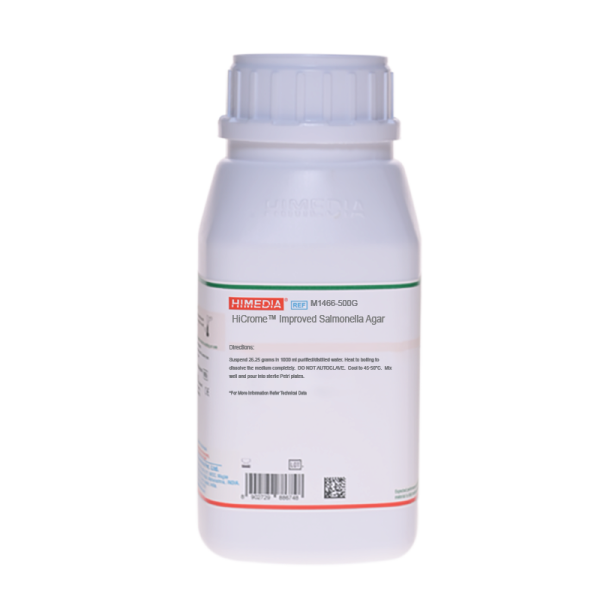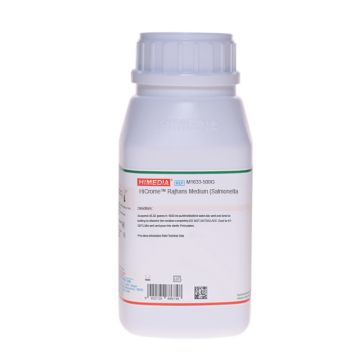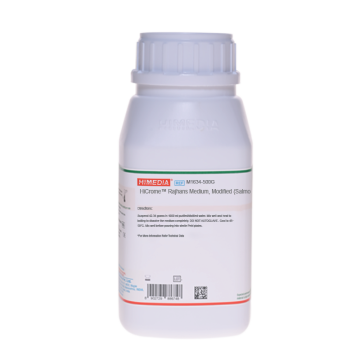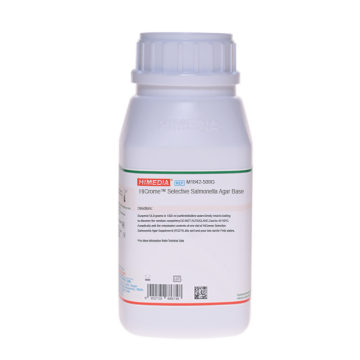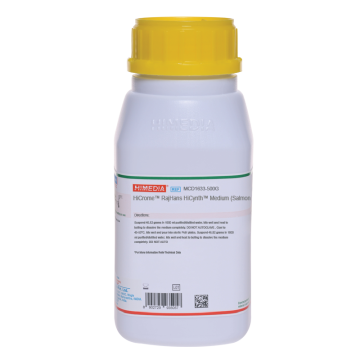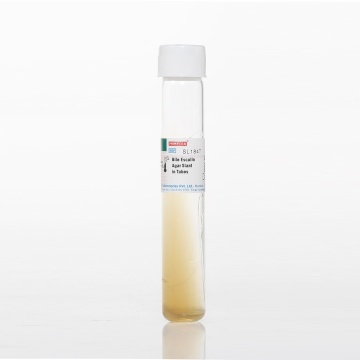 Your enquiry has been submitted
Your enquiry has been submitted
HiCrome™ Improved Salmonella Agar
Selective Isolation Media#CC293D
Intended Use
Recommended as an improved selective and differential medium for Salmonella species.
Composition**
| Ingredients | g / L |
|---|---|
| Peptone, special | 8.000 |
| Yeast extract | 2.000 |
| Sodium deoxycholate | 1.000 |
| Chromogenic mixture | 3.250 |
| Agar | 12.000 |
Final pH ( at 25°C): 7.3±0.2
**Formula adjusted, standardized to suit performance parameters
Directions
Suspend 26.25 gram in 1000 ml purified/ distilled water. Gently heat to boiling to dissolve the medium completely. DO NOT AUTOCLAVE. Cool to 45-50°C. Mix well and pour into sterile Petri plates.
Principle And Interpretation
Salmonella species have been isolated from humans and almost all animals throughout the world. They cause many types of infections from mild, self-limiting gastroenteritis to life threatening typhoid fever. Salmonella Typhi and Salmonella Paratyphi A & B cause gastroenteritis, bacteremia and enteric fever, Salmonella Choleraesuis causes gastroenteritis and enteric fever, especially in children. Salmonella Typhimurium is the most frequently isolated serotype of Salmonella (1). HiCrome™ Improved Salmonella Agar is a modification of the original formulation of Rambach (2) and is used for the differentiation of Salmonella species from other enteric bacteria. Rambach formulation differentiates Salmonella based on propylene glycol utilization and presence of a chromogenic indicator. However, HiCrome™ Salmonella Agar, Modified uses only a chromogenic mixture which contains chromogenic substrate and indicator dye for identification and differentiation of Salmonella species.
Peptone special and yeast extract provides nitrogenous, carbonaceous compounds, long chain amino acids, vitamins and other essential growth nutrients. Escherichia coli and Salmonella are easily distinguishable due to their colony characteristics. All Salmonella species isolated from food or clinical sample exhibit pink to red colonies including Salmonella Typhi. E. coli exhibits a characteristic blue to purple colour, due to presence of the enzyme specific for chromogenic substrate. Sodium deoxycholate inhibits gram-positive organisms.
Type of specimen
Clinical samples: faeces, urine, etc.; Food samples; Water samples
Specimen Collection and Handling
For clinical samples follow appropriate techniques for handling specimens as per established guidelines (5,6).
For food samples, follow appropriate techniques for sample collection and processing as per guidelines (3).
For water samples, follow appropriate techniques for sample collection, processing as per guidelines and local standards (4).
After use, contaminated materials must be sterilized by autoclaving before discarding.
Warning and Precautions
In Vitro diagnostic use. For professional use only. Read the label before opening the container. Wear protective gloves/ protective clothing/eye protection/face protection. Follow good microbiological lab practices while handling specimens and culture. Standard precautions as per established guidelines should be followed while handling clinical specimens. Safety guidelines may be referred in individual safety data sheets.
Limitations
- The medium is selective for Salmonella may not support the growth of other microorganisms.
- Most of the Salmonella strains show pink-red colonies except few which may show colorless colonies.
- Due to nutritional variations, some strains may show poor growth.
- Final confirmation of suspected colonies must be carried out by serological and biochemical tests.
Performance and Evaluation
Performance of the medium is expected when used as per the direction on the label within the expiry period when stored at recommended temperature.
Quality Control
Appearance Light yellow to pink homogeneous free flowing powder
Gelling Firm, comparable with 1.2% Agar gel.
Colour and Clarity of prepared medium Reddish pink coloured, slightly opalescent gel forms in Petri plates
Reaction Reaction of 2.62% w/v aqueous solution at 25°C. pH : 7.3±0.2
pH 7.10-7.50
Cultural Response Cultural characteristics observed after an incubation at 35-37°C for 24-48 hours.
| Organism | Inoculum (CFU) | Growth | Recovery | Colour of Colony |
|---|---|---|---|---|
| **Bacillus spizizenii ATCC 6633 (00003*) | >=104 | inhibited | 0% | |
| Escherichia coli ATCC 25922 (00013*) | 50-100 | luxuriant | >=50% | green to blue |
| Salmonella Typhimurium ATCC 14028 (00031*) | 50-100 | luxuriant | >=50% | pink to red |
| Salmonella Enteritidis ATCC 13076 (00030*) | 50-100 | luxuriant | >=50% | pink to red |
| ## Proteus hauseri ATCC 13315 | 50-100 | good | 40-50% | light brown |
| Salmonella Typhi ATCC 6539 | 50-100 | good-luxuriant | >=50% | light pink |
| Staphylococcus aureus subsp. aureus ATCC 25923 (00034*) | >=104 | inhibited | 0% |
Key: (*) Corresponding WDCM numbers and
**Formerly known as Bacillus subtilis subsp. spizizenii
## Formerly known as Proteus vulgaris
Storage and Shelf Life
Store between 15-25°C in a tightly closed container and the prepared medium at 2-8°C. Use before expiry date on the label. On opening, product should be properly stored dry, after tightly capping the bottle in order to prevent lump formation due to the hygroscopic nature of the product. Improper storage of the product may lead to lump formation. Store in dry ventilated area protected from extremes of temperature and sources of ignition Seal the container tightly after use. Product performance is best if used within stated expiry period.
Disposal
User must ensure safe disposal by autoclaving and/or incineration of used or unusable preparations of this product. Follow established laboratory procedures in disposing of infectious materials and material that comes into contact with clinical sample must be decontaminated and disposed of in accordance with current laboratory techniques (5,6).
Reference
- Murray P. R., Baron J. H., Pfaller M. A., Jorgensen J. H. and Yolken R. H., (Ed.), 2003, Manual of Clinical Microbiology, 8th Ed., American Society for Microbiology, Washington, D.C.
- Rambach A., 1990, Appl. Environ. Microbiol., 56:301.
- Salfinger Y., and Tortorello M.L. , 2015, Compendium of Methods for the Microbiological Examination of Foods, 5th Ed., American Public Health Association, Washington, D.C.
- Lipps WC, Braun-Howland EB, Baxter TE,eds. Standard methods for the Examination of Water and Wastewater, 24th ed. Washington DC:APHA Press; 2023.
- Isenberg, H.D. Clinical Microbiology Procedures Handbook. 2nd Edition.
- Jorgensen, J.H., Pfaller , M.A., Carroll, K.C., Funke, G., Landry, M.L., Richter, S.S and Warnock., D.W. (2015) Manual of Clinical Microbiology, 11th Edition. Vol. 1.
Revision : 04/2024
| Product Name | HiCrome™ Improved Salmonella Agar |
|---|---|
| SKU | M1466 |
| Product Type | HiCrome™ |
| Physical Form | Powder |
| Origin | Animal |
| Packaging type | HDPE |
| References | 1. Baird R.B., Eaton A.D., and Rice E.W., (Eds.), 2015, Standard Methods for the Examination of Water and Wastewater,23rd ed., APHA, Washington, D.C. |
| Customized Product Available | No |



